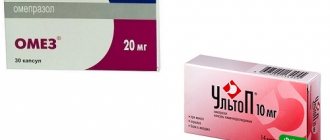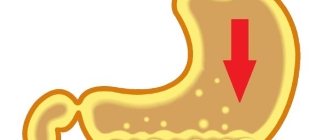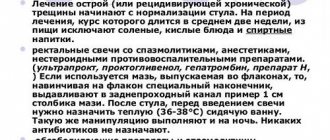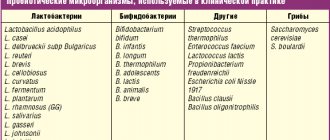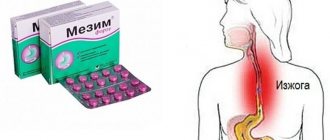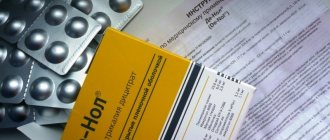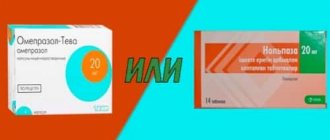Created: 07/17/2019
Updated: 02/24/2021 17:56:39 Share:
*Review of the best according to the editors of expertology.ru. About the selection criteria. This material is subjective in nature, does not constitute advertising and does not serve as a purchase guide. Before purchasing, consultation with a specialist is required.
Proton pump inhibitors (PPIs) are a group of medications that reduce the synthesis of hydrochloric acid in the stomach. Doctors recommend these remedies for both therapeutic and preventive purposes.
Types and list of drugs
There are several generations of PPIs, which differ from each other by additional radicals in the molecule, due to which the duration of the therapeutic effect of the drug and the speed of its onset change, the side effects of previous drugs are eliminated, and interactions with other drugs are regulated. 6 types of inhibitors are registered in Russia.
By generation
1st generation
- Omeprazole . The very first substance of all PPIs was synthesized in the late 70s of the last century. It is the “gold standard” for comparison with other proton pump inhibitors. It blocks the work of cells that produce hydrochloric acid, thereby reducing its concentration in the stomach. The following inhibitors have the same property. It works best in the acidic environment of the stomach, so it is prescribed 20 minutes before meals.
2nd generation
- Lansoprazole . Drugs in this group have not gained much popularity among doctors. Bioavailability (digestibility) after the first use is almost 2.5 times higher than that of omeprazole, and remains the same throughout treatment. The development of the therapeutic effect is faster than that of other PPIs. Blocks both daytime and nighttime secretion of gastric juice, regardless of the time of day when it was taken. The recovery period for hydrochloric acid synthesis is about 13 hours. For better scarring of ulcers, it is necessary to block it for 18 hours daily during the entire course of treatment.
3rd generation
- Rabeprazole . Stops the production of hydrochloric acid for about 28 hours. Minimal interaction with drugs from other groups. Compared to other PPIs, it quickly restores the affected esophagus due to GERD (a disease in which stomach contents periodically reflux into the esophagus, resulting in damage to its mucous membrane).
- Pantoprazole . The group based on this substance is most often prescribed in modern times, since it has been studied for quite a long time and carefully. Has the least side effects with a long course of treatment. Blocks the production of hydrochloric acid for a longer period (about 46 hours). PPIs are the least likely to interact negatively with other medications. Efficiency does not depend on food intake.
- Esomeprazole. It is an isomer of omeprazole, that is, it has the same molecule and radicals, but they are located in a mirror image of each other, which greatly affects the bioavailability of the substance. Esomeprazole has a higher absorption rate. Blocks the synthesis of hydrochloric acid for approximately 16 hours. Begins to act 1 hour after administration.
- Dexlansoprazole. Isomer of lansoprazole. Released in 2009, registered in Russia in 2014. The production of hydrochloric acid is completely restored 4 days after the last dose, the duration of the effect is on average 72 hours. In a single preparation it is presented in the form of 2 types of granules, which dissolve at different times depending on the pH level, thus increasing their effect.
Be sure to read: Duodenitis (inflammation of the duodenum): symptoms and treatment methods
There is also Dexrabeprazole, an optical isomer of rabeprazole, but it does not yet have state registration in Russia.
By active ingredients
Preparations based on omeprazole
- Losek Maps . The original drug omeprazole. The only one that is available in tablets; all other drugs with this substance are capsules. Country of origin: Sweden.
- Omez. One of the most popular PPI drugs. Available in several dosages and combinations: Omez 20 mg (classic dosage), 10 and 40 mg; Omez D (contains omeprazole and domperidone, an antiemetic that is also used to eliminate heaviness in the stomach, nausea, heartburn and other dyspeptic symptoms); Omez Insta (a drug in powder form, due to which it begins to act faster); Omez DSR (also contains omeprazole and domperidone, only in different ratios). India.
Preparations based on lansoprazole
- Prevacid . Original medicine. Not registered in Russia. Used as a remedy for heartburn. Japan.
- Epicurus . Eating reduces the effectiveness and absorption of the active substance by 50%. Russia.
Preparations based on rabeprazole
- Paries. Original medicine. Produced in tablets that dissolve in the intestine. The course of treatment is 14 days, the drug is taken once a day on an empty stomach in the morning. Japan.
- Razo. A relatively new analogue, which is most often prescribed by doctors from drugs in this group. India.
Preparations based on pantoprazole
- Controll. Original drug. Compared to other PPIs, it is chemically more stable at neutral pH (about 7). Germany.
- Nolpaza . It has the greatest variety of dosages and packaging. Can be used in conjunction with clopidogrel. Slovenia.
Preparations based on esomeprazole
- Nexium. Original esomeprazole . It can be used as a maintenance treatment after healing of esophageal erosions for quite a long time without side effects. Sweden .
- Emanera. Often prescribed to protect the stomach in people at risk of developing ulcers while taking anti-inflammatory pain medications. Slovenia .
Drugs based on dexlansoprazole
- Dexilant. Taken to treat ulcers in the esophagus and to relieve heartburn. It is practically not popular among doctors as a drug for the treatment of gastric ulcers. The capsule contains 2 types of granules that dissolve at different times, depending on the pH level. USA.
When prescribing a certain group of “prazoles,” the question always arises: “Which drug is better to choose—the original or its generic?” For the most part, original products are considered more effective, since they were studied for many years at the molecule stage, then preclinical and clinical trials were carried out, interactions with other substances, etc. The quality of their raw materials, as a rule, is better. Manufacturing technologies are more modern. All this directly affects the speed of onset of the effect, the therapeutic effect itself, the presence of side effects, etc.
If you choose analogues, it is better to give preference to drugs produced in Slovenia and Germany. They are meticulous about every stage of drug production.
Proton pump inhibitors - drugs
There are many different PPI drugs and they are all equally effective.
The two oldest PPIs, Lansoprazole (Prevacid) and Omeprazole (Prilosec), are available without a prescription. However, doctors recommend that patients not use PPIs for more than 14 days without consulting their doctor. The need to use them for so long may indicate that the symptoms are caused by a serious problem.
Other PPIs include:
- Pantoprazole (Protonix), which has a lower price than other PPIs
- Dexlansoprazole (Dexilant)
- Rabeprazole (Aciphex), prescribed for people who have difficulty taking pills
Indications for use
All proton pump blockers are used to treat gastrointestinal diseases:
- stomach and duodenal ulcers;
- erosions caused by taking painkillers and anti-inflammatory drugs are also prescribed to protect the stomach during their use;
- ulcerative lesions of the esophagus;
- relief of symptoms: nausea, heartburn, sour belching;
- as adjuncts in complex treatment for the destruction of Helicobacter pylori.
Be sure to read:
The use of prostaglandin preparations in gastroenterology
Causes of heartburn
Common underlying causes of chronic heartburn and acid reflux include:
- stomach ulcer or Helicobacter pylori infection
- GERD
- hiatal hernia
- dysfunction of the lower esophageal sphincter
Anxiety, smoking and drinking alcohol can also cause heartburn and acid reflux in some people. Less common causes of excess stomach acid are Zollinger-Ellison syndrome
and stomach cancer.
PPIs reduce the level of stomach acid that can be produced by parietal cells in the lining of the stomach. It reduces heartburn and acid reflux and makes stomach ulcers easier to heal. PPIs also help cure inflammation of the esophageal mucosa in 90-94% of cases.
People should take PPIs on an empty stomach before meals. Stomach acid helps release active ingredients that can prevent symptoms before they start.
Features of the use of PPIs in various pathologies
These drugs are used only for conditions where the acidity of the gastric juice is increased, since they become active only at a certain pH level. This should be understood in order not to diagnose yourself and not prescribe treatment without a doctor.
Gastritis with low acidity
For this disease, PPIs are useless if the pH of gastric juice exceeds 4-6. At such values, the drugs do not transform into an active form and are simply eliminated from the body, without bringing any relief.
Stomach ulcer
Main article: Stomach ulcer
For its treatment, it is extremely important to follow the rules for taking PPIs. If you systematically violate the regimen, then therapy can drag on for a long time and the likelihood of side effects increases. The most important thing is to take the medicine 20 minutes before meals so that the pH level in the stomach is correct. Some generations of PPIs do not work well in the presence of food. It is better to drink the drug at the same time in the morning to develop a habit of taking it.
Myocardial infarction
It would seem, what does he have to do with it? Quite often, after a heart attack, patients are prescribed the antiplatelet drug clopidogrel. Almost all proton pump inhibitors reduce the effectiveness of this important substance by 40-50%. This occurs because PPIs block the enzyme that is responsible for converting clopidogrel into its active form. These drugs are often prescribed together, because the antiplatelet agent can cause stomach bleeding, so doctors try to protect the stomach from side effects.
The only proton pump blocker that is safest when combined with clopidogrel is pantoprazole.
Systemic fungal diseases
Sometimes the fungus is treated with oral forms of itraconazole. In this case, the drug does not act in one specific place, but on the entire body as a whole. The antifungal substance is covered with a special coating that dissolves in an acidic environment; when pH values decrease, the drug is less absorbed. When prescribed together, the drugs are taken at different times of the day, and it is better to take itraconazole with cola or other drinks that increase acidity.
Be sure to read:
H2-histamine blocking drugs and their use in gastroenterology
Omeprazole against heartburn and its symptoms
It is one of the most affordable hydrogen pump blockers, which can be purchased within 100 rubles. Thanks to the special formula, when using Omeprazole, high absorption of the active substance is observed, which allows you to relieve the unpleasant symptom in the first 20 minutes after administration. Also refers to antiulcer and antigastritis drugs used to quickly relieve burning, pain and other discomfort due to erosive conditions of the gastrointestinal tract.
The drug Omeprazole is one of the most affordable hydrogen pump blockers
The drug is available in the form of capsules and tablets. Enteric capsules are considered more effective, as they release the active substance more slowly, which ensures a long-lasting therapeutic result. For heartburn, patients are not recommended to take more than 1 capsule of the active substance of 20 mg; in case of a severe attack, you can take 1 capsule or tablet of 40 mg. The drug is taken once in the morning. The duration of therapy is 4 weeks for complex treatment of other gastrointestinal pathologies and no more than 3 days for the treatment of burning sensation only.
Attention! When using Omeprazole in patients with severe liver pathology, hepatitis may develop. At the same time, a noticeable increase in liver enzymes in the blood plasma is recorded.
Contraindications
Although the list is not very large, it is important to read this paragraph of the instructions carefully. And be sure to tell your doctor about any illnesses or other medications you are taking.
| Absolute | Relative |
|
|
What should you consider when using blockers?
It is advisable to carry out treatment with hydrogen pump blockers in the presence of heartburn and its accompanying symptoms only when diagnosing chronic or exacerbated diseases of the digestive tract. They belong to complex medications that also suppress pain and partially eliminate inflammation. At the same time, hydrogen pump blockers cause tissue regeneration and scarring of erosions.
Heartburn after eating
When using medications in this group, the age and degree of damage of the patient should be taken into account. Elderly patients tolerate treatment with blockers much worse, so they are usually selected for other treatment regimens or minimal doses of active substances are used.
The following drugs may cause serious side effects, including headache, intestinal upset, rash, worsening heart disease, difficulty breathing, hepatitis, kidney failure, and liver failure.
Alternative PPI drugs
There is another group of antisecretory drugs that are also used for peptic ulcers and other syndromes - H2-histamine receptor blockers. Unlike PPIs, drugs block certain receptors in the stomach, while proton pump inhibitors inhibit the activity of enzymes that produce hydrochloric acid. The effects of H2 blockers are shorter and less effective.
The main representatives are famotidine and ranitidine. Duration of action is about 10-12 hours with a single use. They penetrate the placenta and enter breast milk. They have the effect of tachyphylaxis - the body’s reaction to repeated use of the drug is a noticeable decrease in the therapeutic effect, sometimes even by 2 times. Usually observed 1-2 days after the start of treatment. In most cases, they are used when the issue of the cost of treatment is acute.
Antacids can also be considered alternative drugs. They reduce stomach acidity, but do so for a very short period of time and are used only as emergency aids for stomach pain, heartburn, and nausea. They have an unpleasant effect - rebound syndrome. It lies in the fact that the pH indicator sharply rises after the end of the medicine, the acidity increases even more, the symptoms can worsen with double force. This effect is more often observed after taking antacids containing calcium. Acid rebound is neutralized by eating.
In continuation of the topic, be sure to read:
- What medications should I use for increased gas formation?
- Carminative drugs for adults and children: list of medicines
- Heartburn medications: review of tablets and features of their use
- Rectal fissure: causes, symptoms and treatment of pathology
- Antiulcer drugs for the stomach and duodenum
- Details about the coprogram: preparation, conduct and interpretation of the analysis
- Irritable bowel syndrome: symptoms and treatments
- What laxative is suitable for older people?
- Symbiotics: concept, list of drugs and products
- Antisecretory agents: list and types of drugs, application features
Lansoprazole against heartburn and its symptoms
Officially, this blocker is classified as an antiulcer medication. It is similar in its effects to another popular inhibitor, Omeprazole, but is considered more powerful due to the special structure of radicals that provide a therapeutic effect. Lansoprazole is available only in capsule form for oral use. The advantage of the drug is its increased activity against acidity at the last stage of gastric secretion.
The drug Lansoprazole copes well with heartburn caused by the development of peptic ulcers
Taking into account the presence of other pathologies in the patient and the severity of the main symptom, he may be prescribed Lansoprazole in a dosage of 15 to 60 mg. The classic dosage of the drug is 30 mg of the active substance once in the morning. The recommended course of therapy is 30 days. The simultaneous use of Lansoprazole and antacids based on magnesium and aluminum is allowed, but they should be taken two hours after using the pump.
Attention! The drug copes especially well with heartburn caused by the development of peptic ulcers. With regular use of this hydrogen pump blocker, it is possible to completely heal the wound in 3-4 weeks.
Blockers and pregnancy
According to the latest testing, there is a classification of blockers into risk categories for the fetus according to international FDA standards:
- category B - “Pantoprazole”, “Lansoprazole”, “Dexlansoprazole” - no risks were identified when tested on animals, studies were not conducted among pregnant women;
- category C - “Omeprazole”, “Rabeprazole”, “Esomeprazole” - a negative effect of active substances on the fetus of pregnant animals has been identified; testing has not been carried out among pregnant women, but taking the medication is possible, since the potential benefit is higher.
Side effects of PPIs
One of the most effective and safe drugs in this group is rabeprazole.
Before prescribing a PPI, the doctor determines the benefit-harm ratio. These drugs are not recommended for pregnant women, nursing mothers, or children under 14 years of age. They are strictly contraindicated in case of hypersensitivity to benzimidazole derivatives.
Taking PPIs sometimes causes side effects:
- abdominal pain;
- diarrhea;
- nausea;
- flatulence;
- dry mouth;
- rash, itching;
- headache, dizziness;
- drowsiness;
- pain in joints, muscles;
- weakness.
Since PPIs reduce the absorption of iron salts, iron deficiency anemia may occur due to long-term use of drugs.
Most side effects are short-term and stop after the end of the therapeutic course. Sometimes, with long-term use of PPIs, the following occurs:
- nodular hyperplasia of cells of the gastric mucosa;
- drug-induced hepatitis;
- atrophic gastritis progresses.
Therefore, before taking medications, consulting a doctor is mandatory.
Cost of hydrogen pump blockers
| Drugs | Image | Price in Russia | Price in Belarus | Price in Ukraine |
| Lansoprazole | 300 | 10 | 138 | |
| Omeprazole | 100 | 3,5 | 46 | |
| Esomeprazole | 500 | 17,5 | 230 | |
| Losek MAPS | 600 | 21 | 276 | |
| Omez | 300 | 10 | 138 | |
| Gastrozol | 150 | 5 | 69 | |
| Dexrabeprazole | 500 | 17,5 | 230 | |
| Nexium | 300 | 10 | 138 | |
| Emanera | 500 | 17,5 | 230 |
Attention! The prices shown may vary slightly due to the dosage of the drug. The cost in the table is average and is given in the national currency of the country.
When heartburn attacks occur, it is first recommended to find out the exact cause of the pathology and prescribe medications according to its nature. In the presence of chronic diseases of the digestive system, it is recommended to use a whole range of drugs that can not only remove the burning sensation, but also stop the underlying disease. The use of blockers is most often recommended only in the presence of gastritis, ulcers and other similar gastrointestinal diseases. Read the reasons for pain in the left lower abdomen in men on our website.
Selection of individual therapy with antisecretory drugs
In modern gastroenterology, about 500 drugs are used to treat peptic ulcer disease, which indirectly shows the problem of choosing a specific drug (specific therapy) in each individual case.
Based also on some of the features of PPI therapy listed above (genetics, resistance, nighttime acid breakthroughs, etc.), it can be argued that there is no single “most modern” drug for the treatment of acid-related diseases; the prescription of antisecretory drugs should be individualized and promptly adjusted with taking into account the response to the treatment and, if necessary, should be accompanied by an individual selection of drugs and dosages under the control of pH-metry or gastroscopy.
Emanera against heartburn and related gastrointestinal disorders
The medication is available in the form of enteric capsules for oral administration. The main active ingredient of the drug is the S-isomer of omeprazole, which provides a faster recovery of the patient’s condition than classic omeprazole. Emanera is used in the minimum recommended doses, which is 20 mg of the active ingredient.
Emanera drug
In case of severe disorders and the presence of ulcers and erosive conditions in the patient, the amount of Emaner can be increased to 40 mg. At higher doses, the medication can be used in the morning and evening; with a minimum amount of the active substance, capsules should be taken in the morning. The duration of therapy is one month.
Dexrabeprazole against heartburn and related symptoms
The drug Dexrabeprazole blocks heartburn and excess hydrochloric acid in minimal doses
This drug, based on an improved formula of omeprazole, has not yet received official approval for sale in the pharmacy chain of the CIS countries and the USA. Now it can be ordered from Europe and India. Despite this, Dexrabeprazole has a truly unique effect, since it blocks heartburn and excess hydrochloric acid with minimal doses of 10 mg of the active ingredient. To date, no drug of this type can boast of such a result. But due to insufficient study of Dexrabeprazole, it has not yet been approved for mass production. The duration of treatment is 3-4 weeks.
Esomeprazole against heartburn and other gastrointestinal diseases
According to leading gastroenterologists, this particular drug is considered the most powerful hydrogen pump blocker today. Due to the gradual release of the active substance and its special design, radicals control the production of gastric secretions for more than 12 hours in all patients, in some this figure reaches 17-19 hours.
The drug Esomeprazole is considered today the most powerful hydrogen pump blocker
Esomeprazole is available in the form of tablets for oral administration. When heartburn first appears and there is no accurate information about its nature, 20 mg of the active ingredient should be used once a day, preferably in the morning. After identifying the exact source of the disorder, the dose of Esomeprazole may be 40-60 mg of the active ingredient. The drug is taken for 3-4 weeks.
Attention! Esomeprazole copes well with heartburn caused by ulcers and erosive conditions of the gastrointestinal tract. Already on the first day, an active process of regeneration and scarring of mucosal tissue begins, which additionally relieves pain, nausea, diarrhea and vomiting.
